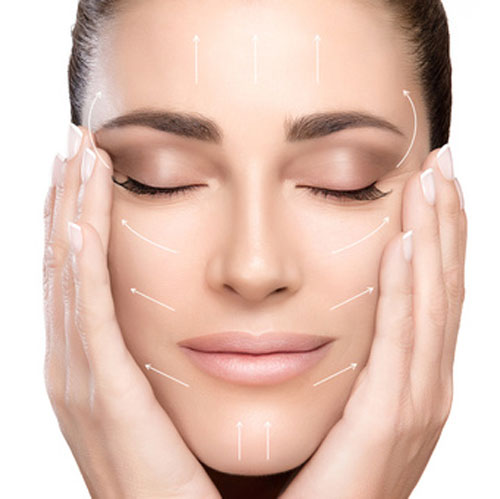Facelift Procedures in Rochester, Rochester Hills, Oakland Township, Lake Orion, Troy, and the rest of Southeast Michigan
What is a facelift?
A facelift, or rhytidectomy, is a surgical procedure that improves visible signs of aging in the face and neck, such as:
- Relaxation of the skin of the face causing sagging
- Deepening of the fold lines between the nose and corner of the mouth
- Fat that has fallen or has disappeared
- Jowls developing in the cheeks and jaw
- Loose skin and excess fat of the neck that can appear as a double chin or “turkey neck”
The loss of youthful contours in the face can be due to variety of factors, including thinning of the skin, loss of facial fat, gravity, sun damage, smoking, as well as heredity and stress.
Other procedures that might be performed in conjunction with a facelift are brow lift and eyelid surgery to rejuvenate aging eyes. Fat transfer or fillers may be suggested to replace the lost fatty volume. Skin treatments such as IPL, dermabrasion, peels or laser may be offered to improve the quality and texture of the skin.
What facelift surgery can’t do
As a restorative surgery, a facelift does not change your fundamental appearance and cannot stop the aging process.
A facelift can only be performed surgically; minimally invasive rejuvenation treatments cannot achieve the same results, but may help delay the time at which a facelift becomes appropriate and complement the results of surgery.
Some minimally invasive treatments, such as stem cell facelifts, are of unproven benefit.
What are the steps of a facelift procedure?
A facelift procedure includes the following steps:
Step 1 – Anesthesia
Medications are administered for your comfort during the surgical procedure. The choices include intravenous sedation and general anesthesia. Your doctor will recommend the best choice for you.
A variety of other procedures can further enhance the outcome of a facelift. They include:
- Facial implants or fat transfer to improve contour
- Resurfacing techniques to improve the tone and texture of facial skin
- Wrinkle reduction by injection of fat or fillers
Step 2 – The incision
Depending on the degree of change you’d like to see, your facelift choices include a traditional facelift, limited incision facelift or a neck lift.
A traditional facelift incision often begins in the hairline at the temples, continues around the ear and ends in the lower scalp. Fat may be sculpted or redistributed from the face, jowls and neck and underlying tissue is repositioned, commonly the deeper layers of the face and the muscles are also lifted. Skin is redraped over the uplifted contours and excess skin is trimmed away.
A second incision under the chin may be necessary to further improve an aging neck. Sutures or skin adhesives close the incisions.
Traditional Facelift
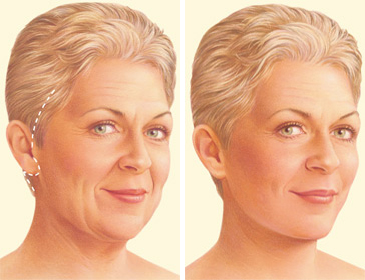
An alternative to a traditional facelift uses shorter incisions at the temples, continuing around the ear. “Mini-lifts” are usually reserved for patients with less skin relaxation, as the results are less rejuvenating than a full facelift.
Limited Incision
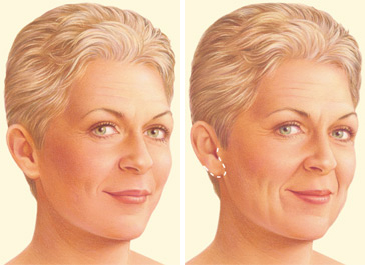
A necklift addresses the sagging jowls, loose neck skin and fat accumulation under the chin. The neck lift incision often begins in front of the ear lobe and wraps around behind the ear, and ends in the posterior hair behind the ear.
Neck Lift
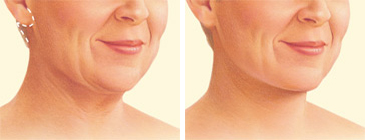
Step 3 – Closing the incisions
The incisions will be closed with sutures that may dissolve or may need to be removed after a few days. Some surgeons use skin glues to seal the incisions. Once healed, the incision lines from a facelift are well concealed within the hairline and in the natural contours of the face and ear.
Step 4 – See the results
The visible improvements of a facelift appear once swelling and bruising subside. Your final result should not only restore a more youthful and rested appearance, but also help you feel more confident about yourself. Get more information about facelift results.
Recuperation and Healing
What should I expect during my facelift recovery?
Following completion of a facelift, a bandage might be placed around your face to minimize swelling and bruising. Small tubes may be present to draw off any excess blood or fluid.
You will be given specific instructions on how to care for the surgical site and drains, medications to apply or take orally, specific concerns to look for at the surgical site or in your general health and when to follow up with your plastic surgeon.
Be sure to ask your plastic surgeon specific questions about what you can expect during your recovery period.
- Where will I be taken after my surgery is complete?
- What medication will I be given or prescribed after surgery?
- Will I have dressings/bandages after surgery?
- When will they be removed?
- When will the stitches be removed?
- When can I wash my face and wear make-up?
- When can I resume normal activity and exercise?
- When can I color my hair or get a haircut?
I am text block. Click edit button to change this text. Lorem ipsum dolor sit amet, consectetur adipiscing elit. Ut elit tellus, luctus nec ullamcorper mattis, pulvinar dapibus leo.
Safety and Risks
What are the risks of facelift surgery?
The decision to have plastic surgery is extremely personal and you will have to weigh the potential benefits in achieving your goals with the risks and potential complications of facelift surgery. Only you can make that decision for yourself.
You will be asked to sign consent forms to ensure that you fully understand the procedure and any risks and potential complications.
Facelift risks, while rare, include:
- Anesthesia risks
- Bleeding
- Deep vein thrombosis, cardiac and pulmonary complications
- Facial nerve injury with weakness
- Fluid accumulation
- Infection
- Numbness or other changes in skin sensation
- Persistent pain
- Poor wound healing and skin loss
- Prolonged swelling
- Skin irregularities and discoloration
- Sutures may spontaneously surface through the skin, become visible or produce irritation that require removal
- Temporary or permanent hair loss at the incisions
- Unfavorable scarring
- Unsatisfactory results may include asymmetry, unsatisfactory surgical scar location and unacceptable visible deformities at the ends of the incisions
These risks and others will be fully discussed prior to your consent. It is important that you address all your questions directly with your plastic surgeon.
